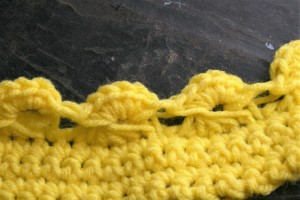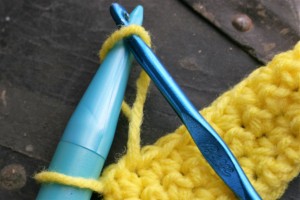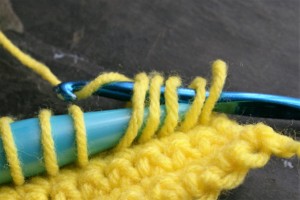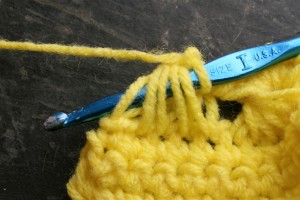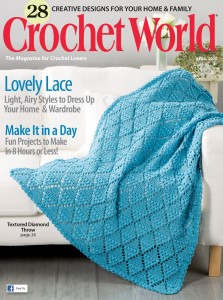 It is hard to believe that I have been home from my adventure of teaching at a national venue for a month now. It has taken me a little while to decompress from the annual Crochet Guild of America conference this year in Charleston, SC. Then arriving home and getting the kids ready to head back to school has delayed my opportunity to really absorb the event. Last week I explained how there was so much going on at the conference that I needed to break it into smaller bites, so today I want to tackle my four classes; Re-Invented Broomstick Lace, Yarn Overload, What the Pattern Doesn’t Say, and Beading Three Ways.
It is hard to believe that I have been home from my adventure of teaching at a national venue for a month now. It has taken me a little while to decompress from the annual Crochet Guild of America conference this year in Charleston, SC. Then arriving home and getting the kids ready to head back to school has delayed my opportunity to really absorb the event. Last week I explained how there was so much going on at the conference that I needed to break it into smaller bites, so today I want to tackle my four classes; Re-Invented Broomstick Lace, Yarn Overload, What the Pattern Doesn’t Say, and Beading Three Ways.
I have taught for a few years in smaller settings, I taught drop in lessons at a coffee shop for 4 fours, more recently I have been teaching weekly at my local yarn store, but teaching at a national conference is a bit different. For one the class size is larger I averaged 16 students per class, with my largest being 20, but they are usually much more focused students that are well prepared and have in depth questions, so it is not a class that you can bluff your way through, you really need to know your material.
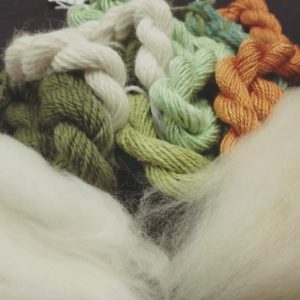
Class materials for Yarn Overload Photo courtesy of the CGOA Facebook page
I also never know what my class room will really look like and I need to bring all my supplies with me. In the local yarn store if a question comes up that I wasn’t prepared for I can find a prop to explain things from items in the store, I always feel that visuals help so much more than just words. At a large conference you are arranged in a hotel meeting or ballroom, so you need to be prepared for random questions and ways of explaining them. Also students expect good handouts, so that they can go home and almost relive the class, local students know that they can access you again in the future if need be.
So after getting all my ducks in a row, and feeling like I have everything together for each class, I walked into my first class, Re-Invented Broomstick Lace, with a few butterflies. The butterflies were primarily from the concern of my relationship with my students. I saw many faces for friends that wanted to support me in my first event, but I always find it a little more difficult to teach friends. It could be the times I have spent as a heckler of my friends teaching, in a good natured way of course, but I know myself well enough to know that to relax in a different setting I might slip into a relaxed situation with my friends and thus not create an inclusive atmosphere for the rest of the class. Fortunately I do not think this occurred, I made a special point to stay professional as much as possible, while still giving personality to the class. It is not an easy undertaking, so I hope I accomplished this! I haven’t received the results of the class evaluations yet, but students did give me positive feedback after the class.
The next class I taught was a complete mental download. Yarn Overload consisted of talking about various aspect of fiber and yarn construction and how it can affect your fabric. Fortunately it was the only class I taught that day, because the material was vast, and the students had some really great questions pressing my knowledge on a variety of fiber crafts, including weaving. I cannot believe that people could listen to me talk that long, but once again I had students expressing how much they really enjoyed the class, I even heard from others at the conference, as word spread about how much was covered in the topic. That makes me feel pretty good. One of the best compliments I received was that one of the students now feels like she can walk into a small yarn store and be empowered instead of intimidated about the yarns in front of her.
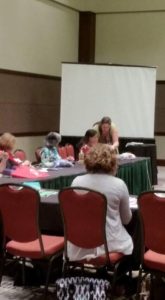
Teaching Re-Invented Broomstick Lace Photo courtesy of CGOA Facebook page
My final day of teaching covered two topics, the first What the Pattern Doesn’t Say followed by Beading Three Ways. There were many ‘Ah ha’ moments for the students during the pattern class, and several people wanted information about my book on the topic, which is not written by the way. I explained many things that you are assumed to know in working patterns, and short cuts, and various ways to create and improve your work. I felt this class was a success as well.
My learning moment came in my last class, which I had to remind myself, it is not the way everything starts it is the way everything ends that is important. Beginning the class I realize that I am missing some important items…needle and thread. The first 2 techniques are taught with them and my sewing tomato pin cushion was nowhere to be found. After a bit of searching and a little regrouping, I had a very generous student offer to run down to the hotel front desk and pick up a stack of emergency sewing packs. I began the class working on the final beading method that did not involve a needle, while the student ran down and picked up supplies. She was a life saver, and fortunately the hotel was gracious enough to accommodate our needs. I managed to keep my composure and I think the class ended much better than it began, at least I hope the students feel it was successful.
I am not sure when I get to see the class evaluations, but I want to learn and grow as a teacher, so this is one of the only tools available for me to enhance the experience in my classroom. You always learn more by teaching, whether it be the skill itself or the art of instruction. This was definitely a learning opportunity for me, which I hope to repeat.
 To find something in crochet that I have never seen before takes some doing, but I was fortunate enough to have one such product find me.
To find something in crochet that I have never seen before takes some doing, but I was fortunate enough to have one such product find me.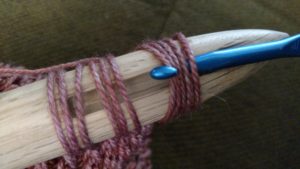 Traditional broomstick lace has been done with a knitting needles. By working loops over a knitting needle and then working the loops back off to create a stitch that sometimes is noted as resembling the eye of a peacock tail. One of the biggest drawbacks to this techniques is that it is a bit awkward…it feels like you need a third hand to hold everything.
Traditional broomstick lace has been done with a knitting needles. By working loops over a knitting needle and then working the loops back off to create a stitch that sometimes is noted as resembling the eye of a peacock tail. One of the biggest drawbacks to this techniques is that it is a bit awkward…it feels like you need a third hand to hold everything.


